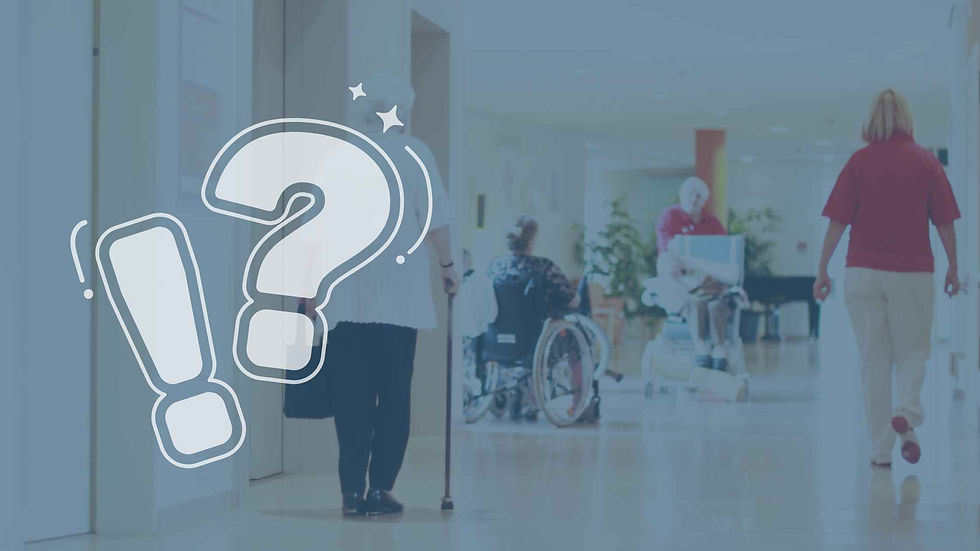Falls in Nursing Homes: Understanding the Risks, Prevention, and Legal Rights
- Fiffik Law Group, PC

- Jul 10, 2025
- 3 min read

Frequency of Falls in Nursing Homes
Falls are a significant concern in nursing homes, affecting a large proportion of residents each year. According to national data, falls are among the most common injuries in these facilities, often leading to serious consequences such as broken bones, particularly hip fractures, and a decline in overall health and independence. The high incidence is due in part to the advanced age and frailty of many residents, but also to lapses in care and supervision.
Causes of Falls: Intrinsic and Extrinsic Factors
If your loved one has fallen, the first step is to investigate the cause of the fall (to prevent future falls). Falls in nursing homes are typically caused by a combination of intrinsic (resident-related) and extrinsic (environmental) factors:
Intrinsic Causes
Intrinsic causes include medical conditions such as blood pressure fluctuations, internal bleeding, muscle weakness, impaired balance, poor vision, medications that cause dizziness, and chronic illnesses like Parkinson’s or diabetes. These causes may reveal that your loved one isn’t falling at all but rather fainting or having a seizure.
Extrinsic Causes
Extrinsic causes involve environmental hazards and facility shortcomings, such as poor lighting, cluttered walkways, slippery floors, lack of grab bars, and improper use or absence of assistive devices.
Steps and Practical Measures for Prevention
Preventing falls requires a systematic, multifactorial approach. Ask the facility to hold a family meeting to discuss what’s been done to determine the cause of your loved one’s falls. The result of the meeting should be a written care plan that includes action steps that might include:
Medical Management
Regularly review and adjust medications to minimize side effects like dizziness. Address treatable conditions that affect balance, such as fluctuating blood pressure, internal bleeding, vision or hearing problems, dehydration, intermittent vertigo, incontinence, and ensure residents receive appropriate physical therapy to improve strength and coordination.
Environmental Modifications
Rearranging room furniture to create clear, unobstructed pathways.
Installing grab bars in bathrooms and handrails in hallways.
Improving lighting and removing trip hazards like loose rugs or uneven flooring.
Assistive Devices
Providing and maintaining devices such as wheelchairs, walkers, and canes tailored to individual needs.
Utilizing bed alarms to alert staff when high-risk residents attempt to get up without assistance.
Employing hip protectors to reduce injury severity if a fall occurs.
Lowering beds to reduce the risk of injury from falls.
In select cases, using chest restraints, though these must be carefully considered due to potential risks and ethical concerns.
Other Interventions
Relocating a resident’s room closer to dining facilities or the nurses’ station for more frequent monitoring.
Ensuring frequent bathroom trips and keeping personal items within easy reach.
Keeping the resident busy while wet floors are drying (a patient with dementia might not be able to read or understand “wet floor” signs or perceive that the floor is wet in the first place).
Legal Rights: Can You Sue After a Fall in a Nursing Home?
If a fall occurs due to negligence such as inadequate supervision, unsafe conditions, or failure to provide necessary assistance, residents or their families may have grounds for a lawsuit against the facility. Nursing homes are responsible for providing a safe environment. They are not required to “guarantee” that falls will not occur. Signs of negligence include repeated falls, unexplained injuries, lack of a care plan that recognizes your loved one’s fall risks or includes clear preventative measures or evidence of poor facility maintenance.
Compensation and Its Use for Resident Care
Successful legal action can result in compensation for:
Medical expenses (hospitalization, surgery, rehabilitation)
Pain and suffering
Emotional distress
Costs of additional care or relocation
In cases of gross negligence, punitive damages may also be awarded
This compensation can be used to cover ongoing medical treatment, hire private caregivers, pay for assistive devices, or fund a move to a safer facility—ensuring the injured resident receives the quality care they need. Additionally, lawsuits for falls in nursing homes often force facilities to make changes so residents are not harmed in the future.
Falls in nursing homes are preventable with diligent care, environmental adjustments, and proper use of assistive devices. When facilities fail in their duty, legal action not only provides compensation but also holds them accountable, helping to improve standards for all residents. If you suspect negligence contributed to a loved one’s fall, consult with one of our experienced Pennsylvania nursing home negligence attorneys to protect their rights and well-being.


